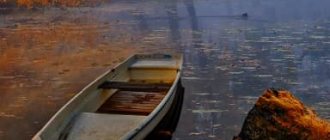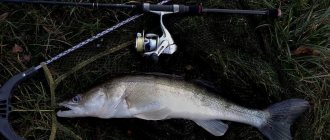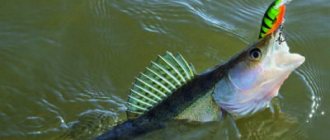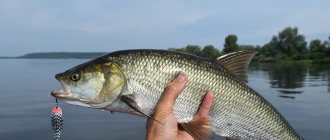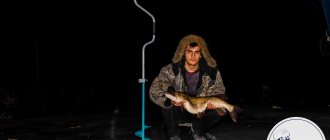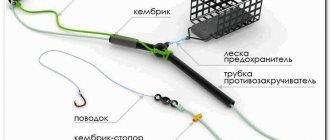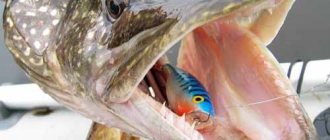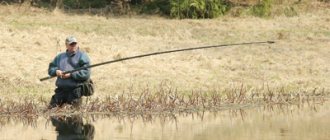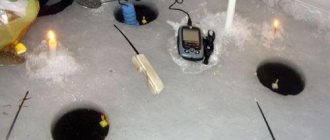Ways to catch pike perch
There are several most popular ways to catch pike perch in October:
- Fishing with spinners
- Jig fishing
- Trolling
- Plumb fishing from a boat
- Bottom fishing with live bait
Catching pike perch with spinners - this method has been known since Soviet times. Such lures for pike perch are quite easy to use, do not require much skill from the angler, and do not place any special demands on the shape of the rod or reel. However, given the weight of the spinners most often used for catching pike perch, it is worth classifying such fishing as light and ultralight fishing. In addition, they will sink into the bottom layer at great depths for too long, and the accuracy of the postings will be lost. Still, spinners work better at shallow depths and catch pike perch in the summer at night.
Thickets of underwater vegetation

In autumn, most of the algae die and sink to the bottom, scaring away picky fish with their unpresentable appearance and smell. However, this does not apply to all vegetation. Some types of algae can live until late autumn.
For example, green algae with wide leaves. Next to them, you can successfully catch pike perch using a float rod with a leech as bait or using wobblers.
Jig fishing
The most popular way of catching autumn pike perch among spinning anglers. It is used throughout the fall - in September, October and November. They practice fishing with silicone fry, brooms, silicone crayfish, mandula, and jig spinners. They fish with a classic jig loaded with a Cheburashka and with a drop-shot rig, which helps fish the pike perch holes centimeter by centimeter, finding a passive pike perch and forcing it to bite. Heads are used relatively rarely, since they involve more uniform wiring in the water column, and not playing with a knock on the bottom.
Farewell to summer. How to catch pike perch in the fall

Even on the coldest autumn days, it makes sense to try to find places with warm water, where a wide variety of fish will rush to warm up and say goodbye to the past summer. And pike perch is no exception to the rule. Where to catch pike perch in the fall?
If there is a pipe on a reservoir from which warm water flows into it, then that is where you should look for fish. If the pipe is not visible, then you can stay close to grooves and channels, the water from which can raise the temperature of the coastal waters by several degrees.
Also, don’t discount the seagulls that will circle over the accumulations of fish gathered in places with warm water. You can fish here with all kinds of bait - both artificial and animal.
And remember that fishing for pike perch in the fall is most effective until November, and in the northern regions until the end of September. Don’t miss the moment of the autumn zhora, because next time you will only be able to catch pike perch well from the ice, or you will have to wait for the new season of open water.
How to catch pike perch for beginner anglers:
Fishing with a retractable leash
Fishing with a retractable leash is not used so often. This method is more suitable for catching perch. Those who want to have a small but stable catch in the autumn should try this type of fishing. In autumn, perch smothers fry in the coastal zone. You can catch some pretty good bast fish using a jig rig with a retractable leader. This will be great practice for a beginner who is taking his first steps in jig fishing. Microjig fishing for pike perch is practically not used. For microjig, lightweight baits are used that work in the water column, and it is better to catch pike perch with a jig running in steps along the bottom.
The following can be said about jig baits and their wiring. All lures are divided into two types - those that have their own game on a uniform retrieve, such as twisters and vibrotails, and those that have no or almost no such game, such as foam rubber, worms, octopuses. For the latter, be sure to use edible silicone or flavor impregnation. They are more often grabbed by passive pike perch, and can easily be spit out if it senses a catch. It is also desirable that all baits have a fluorescent color and are clearly visible in the underwater autumn haze.
Lures
Today's range of lures for spinning fishing is very diverse. Basically, pike perch baits are of a deep nature. The following baits can be classified as pike perch:
- silicone jig baits;
- spinners;
- wobblers;
- paralon fish;
- tackle with dead fish.
Silicone bait options are the most popular when catching fanged predators. The cost of bait is low, and the game is attractive to predators. Near snags, it is advisable to use an offset hook and hide the tip of the hook in the body of the bait. The load in this case should be in the shape of a bullet.
With such baits you can even fish in snags. Today, baits flavored with various attractants are widely popular.
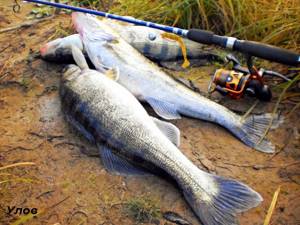
Spinners are classic spinning baits that sometimes outperform other options. Oscillators and turntables from world famous companies have very stable and high-quality play. Many of them are pre-tested, some are handmade.
Therefore, the attractiveness of metal spinners when catching predators is at a high level. And sometimes metal spinners even outperform other baits.
Foam rubber fish are old, unjustifiably forgotten baits. Foam rubber is especially attractive when used for demolition and dragging along the bottom. These postings work well for pike perch in the current.
A rig with a dead fish is a bait for no-bite conditions. The natural smell of the fish is good and the natural appearance works great in conditions of passive fish.
Considering that pike perch, due to the structure of its narrow mouth, prefers narrow fish, then the bait should have a narrow structure. Narrow-bodied silicone fish, narrow spoons and spinners with an oblong petal, narrow wobblers are pike perch baits.
Wobblers are expensive and modern baits. The best wobblers for catching fanged predators are narrow-bodied minnow wobblers and deep cranks. Wobblers are promising when fishing at night in shallow waters.
Trolling
Trolling is a fishing method that helps you quickly find active fish in a large area and provoke them to bite. It is very effective when searching for fish trails, as it allows you to find them in a short time over a large area. However, to successfully troll you need a good boat and a good motor. You need a four-stroke engine, which usually requires a permit, because fishing with a two-stroke under your ear all day can ultimately cause not pleasant fatigue, but a nervous breakdown.
They are caught by trolling with deep-sea wobblers. Be sure to use an echo sounder to timely track changes in the bottom, speed up or slow down the bait so that it runs approximately parallel to the bottom. A good echo sounder will show not only the fish and the bottom, but also the position of the wobbler if it is no more than 30 meters from the boat.
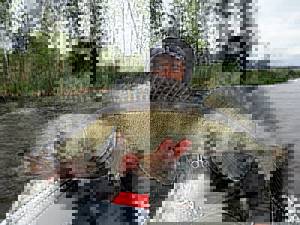
Plumb fishing
Plunge fishing will also require a boat. However, a powerful motor is not required in this case. For fishing, a side rod and a winter type balancer are used, but slightly larger and in a luminous color. When fishing, they try to determine the position of the fish using an echo sounder. Then, along the entire length of this flock, they follow, keeping the boat at a very low speed and correcting the course with the help of rare oar strokes, using a water parachute or an electric motor. When moving, they swing the rod, playing with the balancer and tempting the pike perch to take the bait. Even if the echo sounder shows not a pike perch, but a white fish, most likely a predator is following this school.
Selection of baits and equipment for spinning rods
The most important point when fishing for pike perch is the choice of bait. In fact, this question is quite complex, and is determined by the activity of the fish, its feeding size, the presence of a current and its strength. There are several main types, each with its own application features, equipment features and wiring speed:
1. Jig silicone baits
length from 7 to 14 cm in classic equipment. Familiar forms are used, such as vibrating tails and twisters. They are equipped either on a jig head or with the usual mounting - Cheburashka and double. If the bottom is cluttered, the most effective way is to use an offset hook. The color of the lures depends on the personal experience of the angler, but contrasting colors are recommended.
2. Vibrotails
length from 14 to 23 cm. No matter how large this size may seem, you will be surprised when you catch the most ordinary kilogram pike perch. Equipment exclusively on a jig head, preferably with the mounting eye positioned at an angle of 90 degrees. It is assumed that such a bait will be carried out by the fisherman as slowly as possible with long pauses. The load of the head is selected taking into account the strength of the current and must be lightened to the extreme degree of sensitivity of the wiring.
3. Passive silicone baits
on spaced equipment. For example, artificial worms and slugs. They are distinguished by the absence of their own game and are intended to animate fishermen using additional montages. There are several types of spaced-out rigs, a pull-out leash, a drop-shot, and some others. Fishing in this way is capable of miracles during those periods when the predator refuses to respond to anything else.
4. Foam fish.
They have been known for a very long time and also popular for a long time. Due to the properties of positive buoyancy, it additionally attracts fish, while the bait is a “rogue”, not in the sense of a deceiver and scoundrel, but capable of passing bottom obstacles.
5. Mandula,
aka “flag”, aka “slipper”. Segmental bait, 6 to 10 cm long, made of polyurethane. It has exceptional buoyancy and is equipped with multiple tees. The weights of the lead weights used are clearly overweighted.
6. Jig streamers.
A fly fishing bait adapted for deep fishing, made of artificial or natural fibers.
7. Minnow type wobblers
. They are especially productive when fishing at night for actively feeding predators in shallow water, riffles, and under illuminated bridge supports. Does not require active wiring, the use of extended pauses is mandatory.
8. Deep “deep” wobblers
. Used in common fishing areas. At certain times, especially during periods of warming, they are quite catchy. This is due to the fact that the pike perch changes its usual horizon.
9. Wobblers “vibration” classes
, often called rattlins. They are characterized by an active vibrating game and a fastening located on the back of the bait. Recently, they have become especially popular among spinners. The wiring can be varied, from sharp explosions to smooth long pulls with the rod. They are used in both night and day fishing.
A spinning rod should have several important characteristics. Be sure to pay attention to the rigidity, it is what is responsible for breaking through the bony mouth of the pike perch when hooking. When fishing by boat, the optimal rod length is 240-256 cm. If you plan to fish from the shore, you need to look at the length of 270 cm. The most popular test for fishing on large rivers and reservoirs is 15-50 grams. In medium rivers, depending on the depth and strength of the current, a comfortable test is from 10 to 28 grams, the so-called “ounces”. In exceptional cases, for places with very deep depths and powerful currents, the upper test of the spinning rod can reach 90 and 100 grams.
Reels are used in proportion to the upper test bar of the rod. So, for example, for a rod with a test weight of up to 50 grams, a reel of size 4000 according to the Shimano classification is suitable, at the same time, if lures are used with extreme weight, then it’s time to think about sizes 6000 and 8000, or even switch to using casting gear. By the way, some pike-perch fishermen successfully catch by casting, and tactile sensitivity plays an important role.
It is imperative to use braided cords due to their complete non-stretchability, which allows you to make timely hooking, and due to the high breaking load and low thickness, use a wider range of weights.
The tackle must be equipped with high-quality fittings that can withstand large pike perch and not fail at the most important moment.
